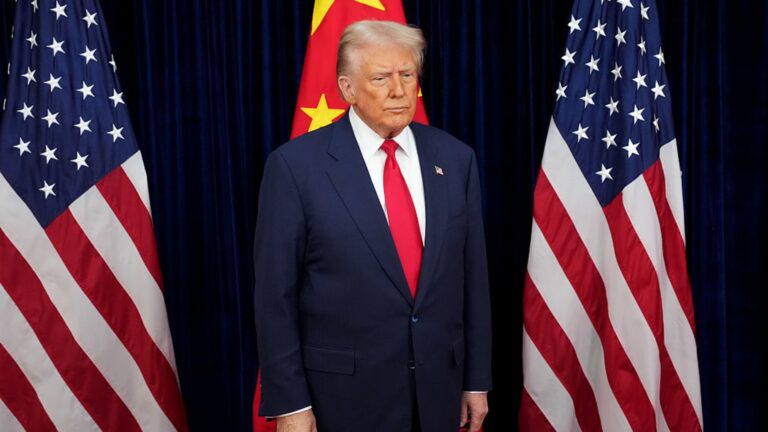U.S. President Donald Trump prepares to greet Chinese President Xi Jinping ahead of a bilateral meeting at Gimhae Air Base on October 30, 2025 in Busan, South Korea.
Andrew Harnik | Getty Images
American shippers were already unhappy about their business outlook after President Donald Trump imposed steep new tariffs on China in April.
And they were not feeling much happier on Thursday, even after Trump announced a new trade truce with Chinese President Xi Jinping.
The consensus among U.S. shippers and logistics managers is that the deal is largely rhetoric and that it does not change the substance of the disagreements on trade between the two nations.
The note that tariffs on Chinese imports, even after the 10-percentage-point cut announced, remain high enough to put a serious dent on import volume.
The effective rate on Chinese imports is still around a minimum of 47% because tariffs are layered on top of each other depending on the physical characteristics of individual imports.
Alan Baer, the CEO of the trucking company OL USA, told CNBC on Thursday, “Uncertainty remains at the forefront of every client conversation as we look out to 2026.”

“Risk management of inventory levels combined with avoiding tariff variability is a central theme for the first half of 2026,” Baer said.
Before Trump and Xi met in South Korea, the effect of the American president’s on-again, off-again tariff threats was seen in U.S. Customs data on containers arriving in the United States from China.
“Apparel has taken the biggest hit so far, with woven apparel down more than 50% and knitted apparel down over 40%,” said Ben Tracy, vice president of strategic business development at Vizion, which aggregates trade data for logistics managers.
“Furniture and toys show the steepest drops by total volume, falling between 20 to 25%,” Tracy said on Thursday.
New data from Vizion shows that year-to-date, the number of containers shipped from China is 2.9 million, which is 700,000 fewer containers than shipped during the same period in 2024
The same data also shows that there are currently 247,000 containers from China on the water headed to the United States. That is about 50,000 fewer containers on the water during the same month in 2024.
Fewer containers to ship means lower profits for trucking companies, warehouse firms, and railroads.
The markedly lower container volume is reflected in the Logistics Managers’ Index, a key metric that tracks inventory levels, warehouse costs, transportation capacity, and pricing.
The LMI over the past two months suggests the freight industry might be headed for a recession.
LMI authors have said that a negative index trend would need to continue for at least three months it would indicate an actual recession.
John Gold, vice president of supply chain and customs policy at the National Retail Federation, said that the deal announced by Trump, which cuts so-called fentanyl tariffs on Chinese imports from 20% to 10%, “certainly provides relief to companies, especially if it leads to further de-escalation of tariffs between the U.S. and China.
“While the tariff rate is still high with the fentanyl and reciprocal tariffs in place, it is a much better alternative we were facing with an additional 100% tariffs,” Gold said.
But he said the remaining tariffs are “harmful” and that “we encourage the administration to continue negotiations with China, as well as other trading partners” to remove those duties.

